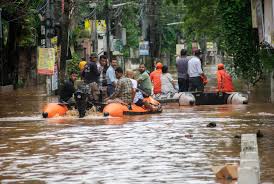Disaster Management (Amendment) Bill, 2024

- 27 Mar 2025
In News:
The Parliament has passed the Disaster Management (Amendment) Bill, 2024, aiming to strengthen disaster response mechanisms.
Ministry: Home Affairs
Background
The Disaster Management Act, 2005 established a three-tier structure:
- National Disaster Management Authority (NDMA)
- State Disaster Management Authorities (SDMAs)
- District Disaster Management Authorities (DDMAs)
These bodies were responsible for disaster planning, mitigation, and response at national, state, and district levels respectively.
Key Amendments
1. Preparation of Disaster Management Plans
- Earlier: Executive Committees were responsible for preparing disaster plans.
- Now: NDMA and SDMA will directly prepare and approve national and state disaster management plans.
2. Expanded Functions of NDMA and SDMA
New responsibilities include:
- Periodic risk assessments, including risks from climate-related events.
- Technical guidance to lower-level authorities.
- Minimum standards of relief recommendations.
- Creation of disaster databases containing:
- Disaster risk profiles
- Fund allocations and expenditures
- Preparedness and mitigation strategies
- NDMA-specific roles:
- Assessment of state preparedness
- Post-disaster audits to evaluate response effectiveness
3. Urban Disaster Management Authorities (UDMAs)
- To be established in state capitals and municipal corporation areas.
- Composition:
- Chairperson: Municipal Commissioner
- Vice Chairperson: District Collector
- Additional members as per state government notification
- Responsible for urban disaster planning and implementation.
4. State Disaster Response Force (SDRF)
- States are empowered to establish SDRFs for specialized disaster response.
- Functions and service conditions to be defined by state governments.
5. Statutory Status to Key Committees
- National Crisis Management Committee (NCMC):
- Nodal body for major national disasters
- Chaired by the Cabinet Secretary
- High-Level Committee (HLC):
- Sanctions financial assistance to states
- Chaired by the concerned Union Minister
6. NDMA Staffing and Appointments
- NDMA can determine the number and type of officers and staff.
- Can appoint experts and consultants with prior central government approval.
Rationale Behind the Amendment
- Climate Change: Increased frequency of extreme weather events necessitates proactive strategies.
- Decentralization Gaps: States faced implementation challenges under the 2005 Act.
- Institutional Strengthening: Clearer roles for national and sub-national bodies.
- Technology and Data Integration: Emphasis on real-time data and performance audits.
Key Concerns and Criticism
- Centralization of Power:NDMA’s enhanced role may reduce state autonomy in disaster response.
- Overlap with State Authority:Potential encroachment on state disaster planning and fund utilization.
- Delayed Relief via NDRF:Increased central oversight may slow localized relief efforts.
- Omission of Emerging Threats:Excludes disasters like heatwaves from official definitions.
- Lack of State-Specific Relief Funds:Demand for region-focused financial provisions by states like Bihar.
Way Forward
- Ensure Federal Balance: Maintain cooperation between Centre and states.
- Update Definitions: Include climate-induced disasters like heatwaves.
- Transparent Funding Mechanism: Clear protocols for fund allocation and usage.
- Empower Local Bodies: Strengthen DDMAs and UDMAs through training and resources.
- Institutional Audits: Regular post-disaster audits to enhance future readiness.
